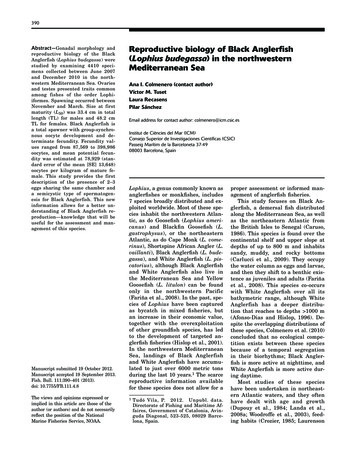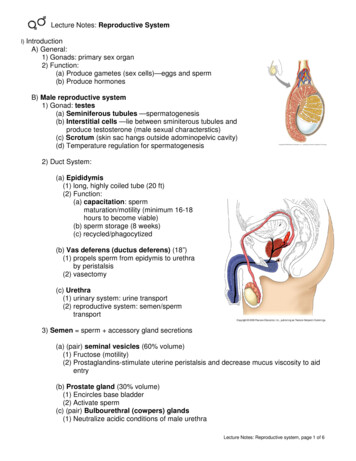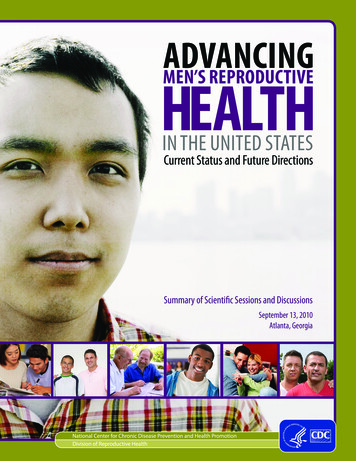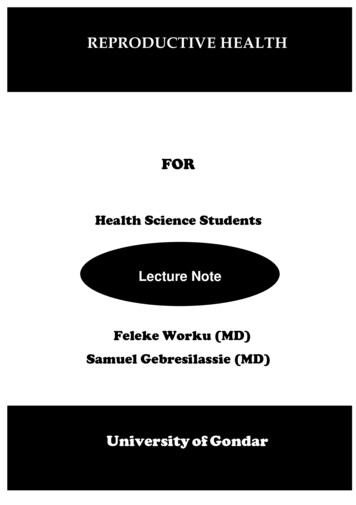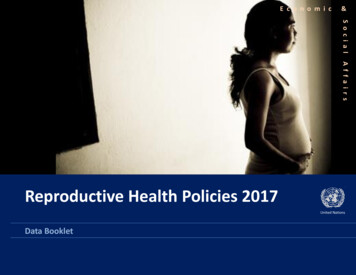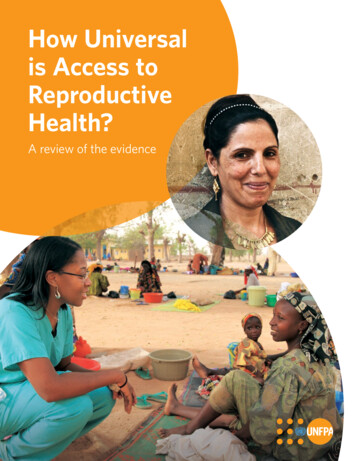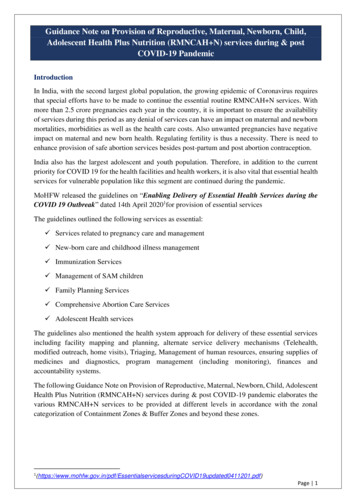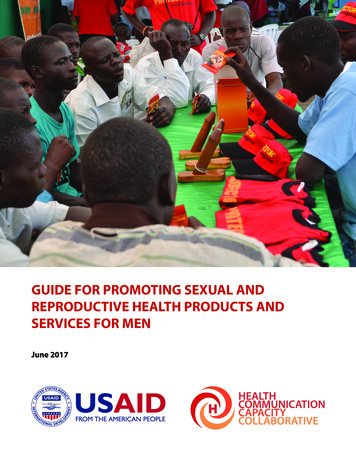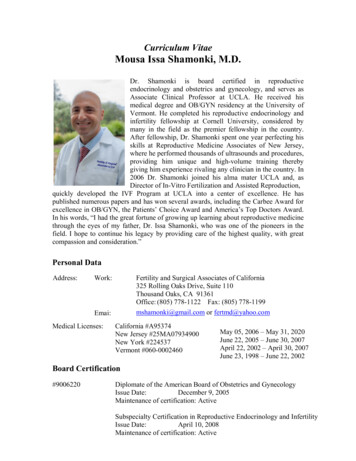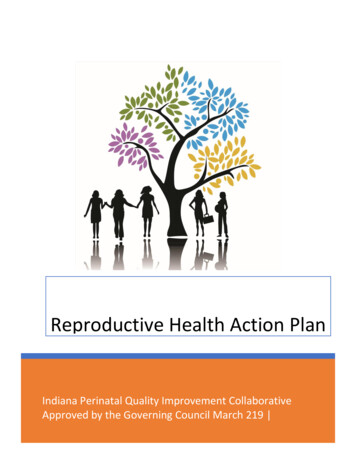
Transcription
Reproductive Health Action Plan2019Indiana Perinatal Quality Improvement CollaborativeApproved by the Governing Council March 219
Table of ContentsIntroduction: . 2Goal:. 2Overarching reproductive cycle goals: . 3I.Pre-childbearing and Adolescent phase . 4II.Childbearing phase. 6III.Post-Childbearing phase . 12Summary . 13Attachment 1: Obstetric Provider Capacity . 15Attachment 2: One Key Question . 16Attachment 3: Potential Partners for Reproductive Health Planning . 18REPRODUCTIVE HEALTH PLANNING TASK FORCE1
Indiana Perinatal Quality Improvement Collaborative (IPQIC)Reproductive Health Planning Task Force Action Plan 2019Introduction:Indiana has the highest infant mortality rate in the Midwest 1. Unfortunately, we have beenunable to move the dial towards improved health care outcomes for Hoosier infants. In 2016,634 infants died before their first birthday in Indiana. We continue to have a rate higherthan the US average which is also above the Healthy People 2010 goal2. A large part of thehigh infant mortality rate is due to racial disparity in that black non-Hispanic infants die at a2-3 times higher rate than white non-Hispanic infants3.Data shows that roughly half of the infant deaths in Indiana are associated with perinatal riskfactors 4. These risk factors include low birth weight, spontaneous preterm birth, unplannedpregnancy, maternal smoking and substance use, poorly controlled chronic maternal healthconditions such as obesity, diabetes and hypertension and lack of initiation of prenatal carein the first trimester. These risk factors are identifiable and therefore potentially amenableto change.Goal:The goal of the Reproductive Health Planning Task Force is to create a 3 to 5-year strategicplan to reduce the high infant mortality rate in Indiana by creating healthier families. Theoverarching goal is to help the families and communities in Indiana work together to createhealthier lifestyles. Earlier work done by the IPQIC Interconception and Preconception taskforce has shown that healthier moms have healthier pregnancies, deliver healthier infantsand create healthy oflove/762.htm12REPRODUCTIVE HEALTH PLANNING TASK FORCE2
We have created a strategic plan that identifies goals, areas of focus and specific action itemsfor each stage of a person’s life regarding reproductive health decisions. This documentoutlines the task force strategic plans based on the reproductive cycle: pre-childbearing oradolescent phase, childbearing phase and post-childbearing phase. We realize that no onecommittee will be able to complete all these action items but the goal is that this documentserves as a blueprint for several committees to work together in a statewide effort toimprove the health of the families in Indiana.Overarching reproductive cycle goals:The IPQIC Reproductive Health Planning (RHP) task force identified specific phases to focusto efficiently address issues that contribute to the high infant mortality rate. The goalsduring each phase of reproductive health planning are as follows.1. Pre-childbearing and Adolescent phase: this phase begins during the adolescentyears and continues until young women and men make a choice to begin a family.a. To develop life-long healthy lifestyle habits and mindsets.b. To develop healthy communities that encourage positive youth and familydevelopment.c. To introduce the importance of reproductive health planning.2. Childbearing phase: this phase begins when women and men begin activelyreproducing and creating families.a. To identify all women and men that desire to start a family and encouraging themto be physically and emotionally ready to begin childbearing.b. To identify perinatal risk factors for adverse pregnancy outcome early forpotential evidence-based interventions to be effective.c. To develop healthy communities that support healthy lifestyle habits and addressmodifiable social determinants of maternal and infant mortality.d. To develop adequate resources for birth spacing for all women to promotehealthier mothers prior to attempting to conceive a subsequent pregnancy.3. Post-childbearing phase: this phase begins after the completion of activechildbearing (actively reproducing years) and continues during the child-rearing andfamily support building phase.a. To develop and promote healthy life long behaviors.b. To promote a healthy family identity and social support of families.c. To prevent unplanned pregnancy after active perceived child-bearing iscompleted.REPRODUCTIVE HEALTH PLANNING TASK FORCE3
In the remainder of the document we will detail and outline areas of focus and specific actionitems in each of these three life cycle phases.I. Pre-childbearing and Adolescent phaseThe areas of focus identified by the task force for this phase include providing education inhealthy lifestyle habits, weight, diet, physical activity, immunization and sexual education toprevent sexually transmitted diseases and unplanned pregnancy. Focus areas also includeeducating young men and women to avoid unhealthy lifestyle habits including smoking,vaping and chewing tobacco, use of illegal or non-prescribed substances.Realizing that young men and women mature and physically develop at different ages thetask force has identified an evidence-based simple assessment for all providers (physicians,advanced practice providers, mental health providers, school nurses, youth case managers,technical school and college advisors, social workers and faith leaders) to ask young men andwomen. The One Key Question (1KQ) has been identified as a nonjudgmental,nondiscriminatory way to begin a conversation to help young men and women identify theirlife goals and priorities. This question involves asking young men and women: “Do you oryour partner see yourself ready to start a family within 1 year?” This question in differentformats provides a starting block for a discussion around reproductive and family planningregardless if the discussant is a medical provider or a youth leader. It also enables adiscussion around identifying life goals and helps young men and women create prioritiesbased on their identified goals.The final area involves a creating a statewide priority to improve HPV vaccination rates inIndiana. The Indiana immunization rates for HPV vaccination are low compared to otherstates . The reasons for low vaccination rates are cost, accessibility for lower socioeconomicfamilies, changed indications for young men and women and misunderstanding the benefitsof the vaccination (as a cancer prevention vaccination).Specific action items for Pre-childbearing and Adolescent phase identified by the IPQICRHP task force.1. Educate all providers (physicians, advanced practice providers, mental healthproviders, school nurses, youth case managers, technical school and college advisors,social workers and faith leaders) on the use and benefits of universal pregnancyintention screening in starting the discussion around life planning includingREPRODUCTIVE HEALTH PLANNING TASK FORCE4
2.3.4.5.reproduction goals. 6,7 Young men and women who desire to become pregnant ordesire their partner to become pregnant are directed to preconceptual health andplanning for a healthy pregnancy. Those do not desire to become pregnant or fortheir partner to become pregnant are directed how to identify their life priorities andprevent unplanned or mistimed pregnancies. The goal is to include young adult malesin the discussion regarding family planning early and often.Educate women’s health providers on the recently released ACOG infographic “21Reasons to see a Gynecologist Before Age 21 Years” 8. This document helps medicalproviders begin a conversation regarding life goals and priorities and sexual healthduring the adolescent years.Focus areas of education and health promotion statewide on the counties with thehighest teen pregnancy rates.Increase access and education regarding the benefits of HPV vaccination as a cancerprevention drug to decrease the stigmata associated with sexual transmission. Thebenefits of HPV vaccination are to decrease the burden of-HPV related cancers inadulthood including cervical, oropharyngeal, anal, vulvar and vaginal cancers thatusually present in the adult phase after inoculation several years earlier. Thisincludes working with college campus student health offices to utilize existingsuccessful campaigns such as the IUPUI HPV bathroom stall campaign. This campaigncould be utilized and spread to other college campuses in Indiana.Develop a primary prevention strategy to promote positive youth development andprevent unintended pregnancy. This strategy would recommend a grant programthat promotes goal setting among adolescents in their communities and encouragesparents to talk about healthy behaviors in the home. This has been a successful venuein the past. Sexual Risk Avoidance Education funds and Personal ResponsibilityEducation Program grants support funding for health education programs across thestate. Seeking additional funding and promoting the implementation of curricula suchas Making a Difference, the Teen Outreach Program and other evidence-based6JohnsonK, Posner SF, Biermann J, Cordero JF, Atrash HK, Parker CS, Boulet S, Curtis MG; CDC/ATSDRPreconception Care Work Group; Select Panel on Preconception Care. Recommendations to improvepreconception health and health care--United States. A report of the CDC/ATSDR Preconception Care WorkGroup and the Select Panel on Preconception Care. MMWR Recomm Rep. 2006 Apr 21;55(RR-6):1-23.7 Prepregnancy counseling. ACOG Committee Opinion No. 762. American College of Obstetricians andGynecologists. Obstet Gynecol 2019;133:e78–89.8 CTIVE HEALTH PLANNING TASK FORCE5
curricula will equip adolescents with skills and knowledge necessary to make choicesthat will enable them to achieve their personal goals.6. Focus education and media on teens and adolescents regarding the dangers ofcigarette smoking, vaping and chewing tobacco. These unhealthy behaviors cancontribute to lifelong health issues and are risk factors for adverse pregnancyoutcomes leading to infant and maternal mortality.II.Childbearing phaseIdeally this area begins when a young man or woman answers “Yes” to the one key questionregarding their desire to start a family within the next year. This should identify animportant transition to all providers of young adults including physicians, advanced practiceproviders, school nurses, therapists, mental health workers, youth case managers, collegeand technical school advisors, faith leaders, etc.One of the primary areas of focus identified by the task force during the childbearing yearsinclude stressing the importance of the preconceptual visit to include discussion andeducation regarding optimal maternal health, smoking, substance use disorder, mental andphysical health readiness and assessment of possible genetic issues. There wasconsideration in the task force that any primary care visit should be viewed as apreconceptual visit if the patient had answered the one key question affirmatively.A second area of focus identified by the task force is to work to eliminate barriers to prenatalcare for women in Indiana. These barriers to adequate prenatal care may include a lack ofproviders as there are 32 of the 92 Indiana counties without OB providers per the mostrecent state data9. There are an equal number of Indiana counties that do not havedelivering or birthing centers. Both require women and families to travel great distances fornot only delivery but for prenatal care.The task force recognizes that racial disparity plays a key role in women’s health during thechildbearing years. Black women share a higher burden of medical conditions includinghypertension, diabetes and obesity. Preexisting medical conditions, socioeconomic factors,and educational level are contributing factors to the disparity seen in black women’shealthcare. Although statistical data from studies validate the increased risk factors thatcontribute to both infant and maternal mortality in black women, not all patients have theseknown components. There are recent reports in the lay media of near misses and maternaldeaths in black women with known and unknown medical conditions and complications9Unpublished data. See attachment 1REPRODUCTIVE HEALTH PLANNING TASK FORCE6
including Serena Williams, Kira Johnson and Shalon Irving.10 These situations have been feltto be largely due to implicit or unconscious bias among health care providers in caring forblack women. The task force felt that implicit bias on the part of health care providers maycontribute to racial and ethnic disparities in health. The task force felt that healthcareproviders must become knowledgeable about their own implicit biases and ways toeliminate their own biases in the care of minority women.The task force felt that optimal birth spacing would improve the chances of a successfulhealthy pregnancy. The ideal pregnancy length is 39 to 40 weeks. There is an optimal birthspacing length that decreases the chance of fetal and infant mortality. The length of timebetween giving birth to one baby and getting pregnant with the next should be 18 months ormore11 [8]. Women who get pregnant sooner than that are more likely to have a prematurebaby.“Significant public health disparities exist surrounding teen and unplanned pregnancy in theUnited States. Women of color and those with lower education and socioeconomic status areat much greater risk of unplanned pregnancy and the resulting adverse outcomes. Unplannedpregnancies reduce educational and career opportunities and may contribute tosocioeconomic deprivation and widening income disparities. Black and Latina teenagers aremore than twice as likely as white teenagers to experience a pregnancy, with half of blackand Latina teens becoming pregnant before age 20. Half of teen mothers do not receive a highschool diploma by age 22, perpetuating a cycle of lower educational attainment and poverty.”12 Methods of contraception that have been shown to be the most effective with the lowestfailure rates are those forms known as long acting reversible contraception (LARC). LARCmethods including intrauterine devices (IUDs) and implants work by preventing fertilization.The task force was aware that more education was needed in both providers and patientsregarding the benefits of LARC as an evidenced-based method of birth spacing. In addition,lack of access to an insurance coverage for these most effective methods was identified as aneed to be addressed at the state-wide, local and institutional levels.The task force members also felt that we needed to address the level of maternal smokingduring pregnancy. Nearly 14% of women report that they smoke during pregnancy13. marternal-mortality-symposium/Interpregnancy Interval and Adverse Pregnancy Outcomes: An Analysis of Successive Pregnancies. Hanley,Gillian E. PhD; Hutcheon, Jennifer A. PhD; Kinniburgh, Brooke A. MPH; Lee, Lily MPH. Obstetrics & Gynecology:March 2017 - Volume 129 - Issue 3 - p 8(16)00301-X/fulltext13Indiana State Department of Health. Indiana Natality Report, State and County Data 2015. PublishedDecember 2016. www.in.gov/isdh/19095.1011REPRODUCTIVE HEALTH PLANNING TASK FORCE7
Indiana ranks as the 11th highest state in maternal smoking. Smoking is a well-known riskfactor for prematurity, low birth weight, preterm birth, miscarriage and SUIDS (suddenunexpected infant death syndrome).The task force felt that in pregnancies that do not end in a live birth such as miscarriage,stillbirth, ectopic and pregnancy termination, there is an important but often missedopportunity to effect a change and optimize and women’s chance of successfully completing asubsequent healthy pregnancy if she chooses or preventing a subsequent unplannedpregnancy. The task force felt that urgent care and hospital emergency room facilities couldbetter assist in arranging continuing care and insurance coverage until follow up care wasestablished.The rising substance use disorder (SUD) rate during pregnancies was felt to contribute to thehigh infant mortality rate in Indiana. Thus, the task force identified that providing womenand families with better access for medication-assisted therapy for women with SUD duringand, importantly, continuing after pregnancy would improve the high infant mortality rate inIndiana. Women with SUD must have effective forms of contraception (LARC methods)accessible and readily available to ensure they meet treatment and family goals beforeattempting another pregnancy, if desired.Specific action items for Childbearing phase identified by the IPQIC RHP task force.1. Define and educate providers regarding the key components of a preconceptual visit.Disseminate this information to providers around the state to improve patient careand patient education to optimize maternal health prior to pregnancy.2. Provide implicit bias training for healthcare providers in Indiana using existingeducational programs and the planned March of Dimes training. Indiana is now a statepartner with Alliance for Innovation on Maternal Health (AIM), a program sponsoredby ACOG. AIM has a practice bundle on health equity.These training opportunities support an awareness for providers on unconsciousbias that can affect the health care they deliver to minority patients.3. Work with Indiana Family Social Services Administration (FSSA) to increase access tocare and eliminate potential barriers by extending postpartum coverage to allowwomen with chronic medical conditions including substance use disorder more timeand access to optimize their health. This has long term dividends regarding theimproving the overall health of families in Indiana. A recent legislative initiative inMissouri resulted in the extension of postpartum coverage for one year for womenwith substance use disorder. Other suggestions to consider are to decrease theREPRODUCTIVE HEALTH PLANNING TASK FORCE8
4.5.6.7.number of cases requiring prior authorization including treating women withsubstance use disorder and incentivizing earlier entry into prenatal care financiallyusing MK reimbursement policies. In addition, the task force felt that patientenrollment into Medicaid funded programs during pregnancy may need to beevaluated regarding potential barriers.Determine the current accessibility and needs of women in the state regarding accessto affordable long acting reversible contraception (LARC) in both outpatient andinpatient settings (immediate postpartum placement of IUDs and implants). This willassess the supply of trained LARC insertion providers using multiple contacts:A. Delivering facility nursing and pharmacy leadersB. County health commissionersC. Healthcare providers (state Nurse Practitioner Association, CNM, Indianaprovider professional associations including ACOG, AAP, AAFM)D. College, university, secondary and trade school campus health carerepresentativesE. Special groups such as incarcerated women or juveniles, high schools,homeless shelters, domestic violence shelters and food pantries.Provide multiple venues to increase LARC insertion training among current women’shealth care providers (OBGYN, Pediatrics, Family Medicine, Certified Nurse Midwives,Nurse Practitioners, Physician Assistants). These training venues can include localand large statewide meetings.A. Labor of Love ConferenceB. ISDH Breastfeeding ConferenceC. Indiana statewide professional meetings such as Indiana sections of chaptersof the American College of Obstetricians and Gynecologists (ACOG), AmericanAcademy of Pediatrics (AAP), and the American Academy of Family Medicine(AAFM) meetings.D. We will also assemble a training team to travel to local sites in areas outside ofmetropolitan Indianapolis for immediate postpartum IUD placement, IUDinsertion and Nexplanon insertion training.Initiate and perform same day LARC insertion quality improvement projects at selectsites around the state to improve the access to care for women in rural areas. Thiswill involve mobile sites and training to increase provider training.Identify LARC insertion trained care provider champions in each perinatal region,hospital systems and specialty to provide ongoing navigation and troubleshooting toset up LARC contraceptive insertion sites.REPRODUCTIVE HEALTH PLANNING TASK FORCE9
8. Create mass public educational campaign to EDUCATE patients regarding the benefitsof birth spacing and prevention of teen and unplanned pregnancy using LARC inmultiple venues (social media, print, blogs, audiovisual, buses, billboards, multimedia,public service announcements, radio talk shows) using prepared vetted culturallysensitive messages.9. Provide focused education to increase awareness among influential stakeholders anddecision makers regarding the benefits of optimal birth spacing to reduce Indiana’shigh infant and maternal mortality. We plan to discuss the safety, method of action(prevent fertilization and not abortifacient), and failure rates of LARC methods.10. Increase collaboration with statewide stakeholders 14including:A. Indiana University School of Medicine and Indiana University Clinical andTranslational Sciences Institute to provide data analytics for statewidedeployment of improved contraception access. This will include creating amobile LARC training, counseling and insertion vehicle to reach places withvery limited access or access limited by religious affiliation.B. Perinatal Level 3 and 4 hospitals: Assist level 3 and 4 hospitals in therequirement to provide ongoing educational sessions and qualityimprovement projects in all the delivering hospitals in Indiana for providers,lactation consultants and obstetric nurses regarding updates on therapiesduring pregnancy to reduce infant mortality including:a. training on topics such as breastfeeding with LARC, the benefits ofimmediate postpartum placement of LARC and breastfeedingdifficulties.b. the benefits and recommendations of aspirin therapy to reduce therisk of preeclampsia in women with hypertension and priorpreeclampsia.c. the use of hydroxyprogesterone therapy to prevent preterm birth inwomen with a prior history of preterm birth.d. the use of late preterm corticosteroids to reduce respiratory distresssyndrome (RDS).e. evidence-based smoking cessation methodology that is readily andcurrently available.f. promotion of parental and family education regarding safe sleep andpostpartum family support therapy including the use of postpartumdoulas.14See Attachment 2REPRODUCTIVE HEALTH PLANNING TASK FORCE10
g. using medication-assisted therapy for the treatment for women withopiate use disorders in pregnancy and postpartum.h. education regarding the early recognition and treatment of perinatalmood disorders.C. Indiana Family Health Council has expertise to help create an inventorystockpile of affordable, low cost contraceptive devices for women that cannotafford or have access to contraception. This expertise can help with ordering,managing supply and shipping of LARC methods to sites around the state inneed of low-cost contraceptive devices.D. Indiana State Department of Health “LIV” app, Mom’s Helpline and 211: Ourplan is to utilize already existing state informational platforms that have a tollfree phone number for women to call in and determine where pregnancy,women’s health care and contraceptive services are available in their area.E. WIRSHARP (Workgroup on Implementation for Reproductive and SexualHealth Advocacy, Research, and Programs) is an existing statewide Pediatricand Women’s Health collaborative formed between IUSM, Indiana Section ofthe American Academy of Pediatrics (AAP),Indiana Section of AmericanCollege of Obstetrics and Gynecology (ACOG), and key community stakeholdersto focus efforts of improving adolescent access to contraception.F. Indiana professional societies including Indiana Section of ACOG, IndianaSection AAP and Indiana Section AAFM can provide advocacy statewide toproviders, patients and policy stakeholders.G. Develop a strategy to focus on specialists taking care of nonpregnant women ofchildbearing age with chronic disease to include a discussion and provision forcontraception until they are healthy enough for childbearing or eliminatingunplanned pregnancy.11. Convene a working group of providers, lactation consultants and nurses to discuss,create and disseminate a document regarding the recommendations for LARC usageand concurrent breastfeeding that is consistent with breastfeeding recommendationsand provides safe access for women in Indiana.12. Expand and extend tobacco smoking cessation programs to all counties that currentlydo not have this service.13. Emphasize the dangers of cigarette smoking and vaping during pregnancy andpostpartum to all providers including nursing, medical and advanced practiceprovider students such that dissemination is widespread. The task force also felt thatcurrent medical providers needed to be better educated on the hazards of smokingand vaping during pregnancy including an association with SUIDs, preterm birth,REPRODUCTIVE HEALTH PLANNING TASK FORCE11
prematurity, fetal and infant death. This may include incentivizing smoking cessationusing Medicaid reimbursement policies.14. Develop community education programs about the dangers of cigarette smoking,tobacco chewing and vaping during pregnancy and postpartum. The areas of focusshould initially include those counties or regions with the highest smoking rates andthose with the highest infant mortality rates.15. Work with Indiana Hospital Association and hospital emergency rooms around thestate to improve follow up care for patients without a live birth (miscarriage,stillbirth, ectopic pregnancy and pregnancy termination) and without establishedcare. This may include getting patients signed up for medical insurance care duringthe primary visit.16. Establish an ongoing direct working relationship with the newly formed MaternalMortality Review Committee (MMRC) to determine and direct attention topreventable causes of maternal death. This connection will allow the task force torespond and quickly direct attention to those recurring preventable causes ofmaternal death as maternal and infant mortality are directly related.III.Post-Childbearing phaseThis phase begins after the completion of active childbearing (actively reproducing years)and continues during the child-rearing and family support building phase. During this phasethe task force identified healthy weight management as a critical area of focus as manywomen are unable to maintain a healthy body weight. The task force felt this was phase wasassociated with a lack of education regarding ongoing unhealthy lifestyle habits includingsmoking, substance use disorder, physical activity and an unhealthy diet.The task force also felt during this post-childbearing phase access to adequate contraceptionand sterilization methods was important including vasectomy, tubal ligation and LARCmethods. This would help to prevent unplanned pregnancy during this period.The task force felt that communities would play an influential role in improving the health offamilies by providing places where families can meet, play and feel safe. These places includelibraries, parks, playgrounds, recreation areas, bike trails, and after school care areas.Specific action items for post-childbearing phase identified by the IPQIC RHP taskforce.REPRODUCTIVE HEALTH PLANNING TASK FORCE12
1. Increase the number of providers capable of performing vasectomy servicesthroughout the state. Racial disparity has been noted in the uptake of vasectomy inblack and Hispanic men as they do not generally use vasectomy as a form ofcontraception.15 This should include access for low income and minority malespossibly through providing training and access at FQHCs (federally qualified healthcare centers) throughout the state. Consider partnering with urology provider groupsto provide vasectomy procedural training.2. Continue to provide easy affordable access to all forms of contraception includingLARC and sterilization methods for women throughout Indiana such that unplannedand mistimed pregnancies are decreased.3. Increase community involvement and access to recreation areas including parks andwalking and biking trails. Other areas of importance to the development of healthyfamilies include access to libraries, safe preschool child care, and before and afterschool child care.SummaryThe IPQIC Reproductive Health
We have created a strategic plan that identifies goals, areas of focus and specific action items for each stage of a person’s life regarding reproductive health decisions. This document outlines the task force strategic plans based on the reproductive cycle: pre-childbearing or adolesce
